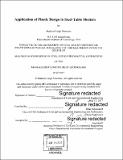Application of plastic design in steel table shelters
Author(s)
Noteware, Madison Leigh
DownloadFull printable version (13.17Mb)
Other Contributors
Massachusetts Institute of Technology. Department of Civil and Environmental Engineering.
Advisor
John Ochsendorf.
Terms of use
Metadata
Show full item recordAbstract
One of the initial applications of plastic theory of structures was the Morrison Shelter, an indoor air raid shelter designed by John Fleetwood Baker (1901 - 1985) during the Second World War to protect British civilians from unrelenting German air raids. Baker integrated his previous work on plasticity of steel frames into the design of Morrison shelters that employed ductility and continuity, which are key principles of plastic theory. Although Morrison Shelters have been praised for their life saving capability and use of plastic theory, a technical analysis of its design process has been lacking from the historical record. To explore the use of plasticity in the Morrison Shelter's design process, the Baker Papers stored in the Churchill Archives Centre were searched. From these materials, the impact of plasticity on the efficiency of steel frames was critically investigated. This study quantifies the savings in steel due to the use of plastic theory in the design of the Morrison Shelter. The value of savings, which was particularly significant during wartime scarcity, has been previously stated without showing technical verification. The Morrison Shelter's design objectives are still relevant today, particularly in developing nations where the use of plasticity to design steel table-shelters can protect school children in areas of high seismic vulnerability by providing shelters in the form of lightweight steel-framed school desks. The investigation of the concise, plastic calculations used to design the Morrison Shelter serve as inspiration for replication in future applications that need lightweight, simple structures that expect to experience impact loads.
Description
Thesis: M. Eng., Massachusetts Institute of Technology, Department of Civil and Environmental Engineering, 2017. Cataloged from PDF version of thesis. "June 2017." Includes bibliographical references (pages 59-62).
Date issued
2017Department
Massachusetts Institute of Technology. Department of Civil and Environmental EngineeringPublisher
Massachusetts Institute of Technology
Keywords
Civil and Environmental Engineering.